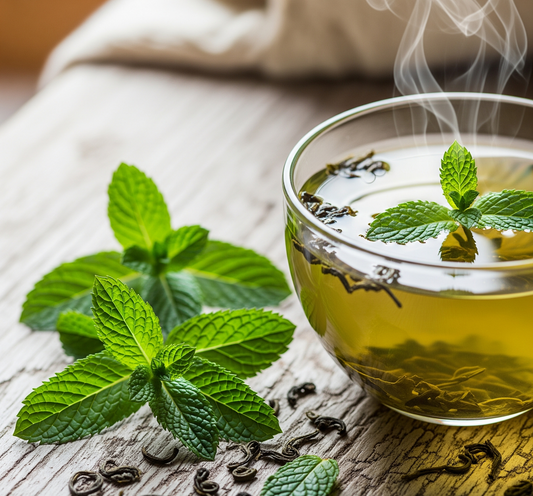Even experienced tea drinkers often confuse matcha and green tea, believing them to be the same. However, they differ significantly in cultivation, processing, flavor, and health benefits. This blog explores these differences, highlighting how matcha is made from shade-grown leaves ground into powder, while green tea consists of steeped leaves. Discover the unique qualities and benefits of both teas.
Even amongst the most experienced tea connoisseurs, a common question that has been echoing through the tea halls since forever is “What is the difference between matcha and green tea?” You won’t have to look too long and hard to come across one group of people who think that both varieties are one and the same, and another who say that they are completely different.
In this blog, we will explore what green tea and matcha are, their similarities, and what sets them apart. We will also explore the preparation methods and health benefits of the two tea varieties. Let’s start with first understanding what green tea and matcha are!
What is Green Tea?

Green tea, like its black, white, and oolong contemporaries, is made from the leaves of the Camellia Sinensis plant. Green tea is one of the most consumed beverages worldwide. Research in the National Library of Health found that (in their cohort) approximately 65.6% of men and 27.5% of women were regular green tea drinkers compared to any other tea.
Compared to green tea sourced from other parts of the world, Nepali green tea stands out due to its exceptional growing conditions and careful processing methods. Grown in the eastern tea mountains of Nepal at altitudes over 3000 meters, these tea plants thrive in mineral-rich soil, resulting in uniquely vibrant and earthy flavors. The leaves are harvested and quickly heated to prevent oxidation, preserving their fresh green color.
The harsh climate, characterized by cold Himalayan winds and warm breezes from the Bay of Bengal encourages the tea plants to produce higher levels of flavonoids, enhancing both taste and nutritional value. Additionally, Nepali producers prioritize organic and sustainable farming practices, ensuring that their teas are free from chemicals and pesticides. This combination of rich terroir and artisan craftsmanship yields green teas that are not only flavorful but also packed with several supposed health benefits.
When brewed, green tea has a light, grassy taste and produces a yellowish-green liquid. Its flavor can be mildly astringent if steeped for too long, making it a refreshing choice for tea lovers everywhere.
Pick from a range of premium organic green tea from Nepal Tea Collective.
What is Matcha?

What might come as a bit of a surprise for some is to learn that technically matcha is also green tea and not actually tisane (a beverage made by infusing herbs, flowers, fruits, or other parts of plants in hot water).
This special type of green tea has gained global popularity in recent years. What sets it apart from regular green tea is that it is made using shade-grown tea leaves that are carefully harvested, dried, and then ground into a fine powder. This shade-growing process enhances the chlorophyll content in the leaves, giving matcha its vibrant and distinct green color.
Preparing matcha is also a unique process that involves whisking the powder in hot water until it becomes frothy. As the powder itself is completely made using tea leaves, you are actually consuming the entire leaf rather than just infusing it in water. As a result, matcha has a comparatively richer flavor profile that combines both sweet and bitter notes.
Let’s look at the differences in more detail!
Key Differences Between Matcha and Green Tea
1. Cultivation and Processing
- Green Tea: Grown in ample sunlight and processed through various methods like steaming or pan-firing.
- Matcha: Grown in shade to enhance flavor and nutrient content; processed by removing stems and grinding leaves into powder.
2. Flavor Profile
- Green Tea: Light, refreshing, with grassy undertones.
- Matcha: Richer and more complex flavor with sweet and bitter notes.
3. Brewing Method
- Green Tea: Steeped in hot water; leaves are discarded after brewing.
- Matcha: Whisked into the water; you consume the entire leaf in powdered form.
Read: A Closer Look into How to Brew Green Tea Properly
Health Benefits of Green Tea

Green tea has been consumed for centuries due to its numerous health benefits:
- Antioxidants: Green tea is rich in polyphenols that combat cell damage from free radicals.
- Weight Loss: Caffeine is known for it calorie burning properties. A typical cup of green tea has around 20–40 mg of caffeine. Although this is typically less than the caffeine found in a regular cup of coffee (100–200 mg) it may still be enough to boost metabolism and aid in weight management.
- Mental Alertness: Contains L-theanine, which promotes relaxation without drowsiness.
Health Benefits of Matcha

Matcha offers many of the same benefits as green tea but often in greater quantities due to its concentrated form:
- Enhanced Focus: The combination of caffeine and L-theanine improves cognitive function.
- Detoxification: High chlorophyll content helps detoxify the body.
- Weight Management: Similar to green tea, matcha may aid in weight loss by boosting metabolism.
- Stronger Antioxidant Effects: Matcha is packed with catechins, particularly epigallocatechin gallate (EGCg), which according to research by the National Library of Medicine, has anti-inflammatory and anticancer properties.
Read more: The Magic of Matcha: Exploring its Health Benefits and Culinary Delights
Caffeine in Matcha vs Green Tea
Caffeine levels vary between matcha and green tea:
- Green Tea: Contains about 11–25 mg of caffeine per gram.
- Matcha: Contains approximately 19–44 mg of caffeine per gram.
If you're a tea drinker who is sensitive to caffeine or looking for a milder option, green tea might be preferable. However, if you need an energy boost without experiencing jitters, matcha could be a better choice.
Matcha vs Green Tea for Weight Loss: Which is Better?
Both matcha and green tea are great options for your weight loss efforts. They both contain catechins that may enhance fat burning during exercise. However, matcha's higher antioxidant levels make it a more potent option for those focused on weight management. So, if you're looking for an energy boost while trying to shed some weight, consider incorporating matcha into your routine.
In summary, matcha and green tea have unique qualities that make them valuable additions to your diet. While they share common roots, they differ significantly in cultivation methods, processing techniques, flavor profiles, nutritional content, and health benefits. Whether you choose matcha or green tea—or enjoy both—you're making a choice that can support your overall well-being.




